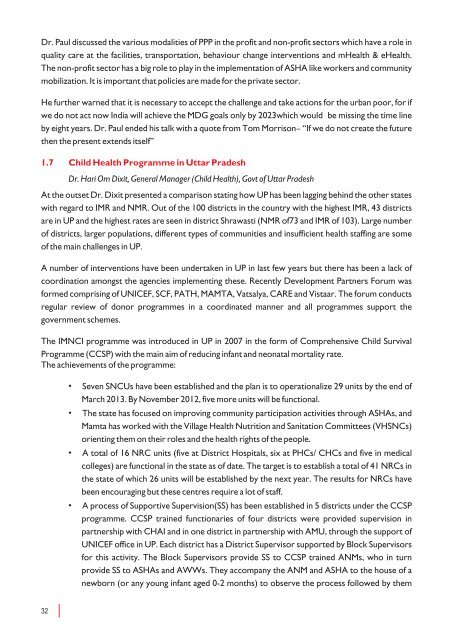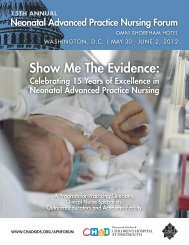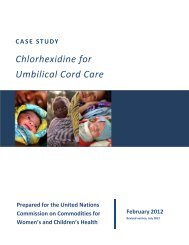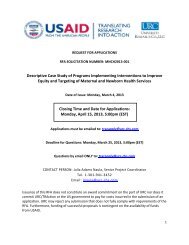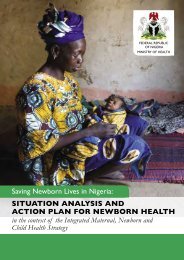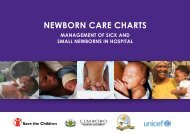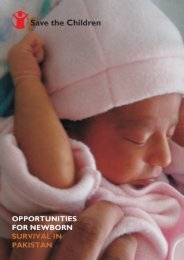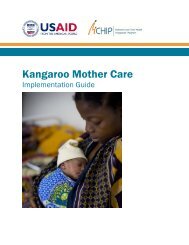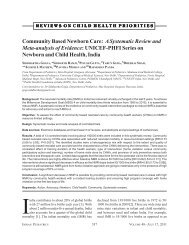Download Resource - Healthy Newborn Network
Download Resource - Healthy Newborn Network
Download Resource - Healthy Newborn Network
You also want an ePaper? Increase the reach of your titles
YUMPU automatically turns print PDFs into web optimized ePapers that Google loves.
Dr. Paul discussed the various modalities of PPP in the profit and non-profit sectors which have a role inquality care at the facilities, transportation, behaviour change interventions and mHealth & eHealth.The non-profit sector has a big role to play in the implementation of ASHA like workers and communitymobilization. It is important that policies are made for the private sector.He further warned that it is necessary to accept the challenge and take actions for the urban poor, for ifwe do not act now India will achieve the MDG goals only by 2023which would be missing the time lineby eight years. Dr. Paul ended his talk with a quote from Tom Morrison– “If we do not create the futurethen the present extends itself”1.7 Child Health Programme in Uttar PradeshDr. Hari Om Dixit, General Manager (Child Health), Govt of Uttar PradeshAt the outset Dr. Dixit presented a comparison stating how UP has been lagging behind the other stateswith regard to IMR and NMR. Out of the 100 districts in the country with the highest IMR, 43 districtsare in UP and the highest rates are seen in district Shrawasti (NMR of73 and IMR of 103). Large numberof districts, larger populations, different types of communities and insufficient health staffing are someof the main challenges in UP.A number of interventions have been undertaken in UP in last few years but there has been a lack ofcoordination amongst the agencies implementing these. Recently Development Partners Forum wasformed comprising of UNICEF, SCF, PATH, MAMTA, Vatsalya, CARE and Vistaar. The forum conductsregular review of donor programmes in a coordinated manner and all programmes support thegovernment schemes.The IMNCI programme was introduced in UP in 2007 in the form of Comprehensive Child SurvivalProgramme (CCSP) with the main aim of reducing infant and neonatal mortality rate.The achievements of the programme:• Seven SNCUs have been established and the plan is to operationalize 29 units by the end ofMarch 2013. By November 2012, five more units will be functional.• The state has focused on improving community participation activities through ASHAs, andMamta has worked with the Village Health Nutrition and Sanitation Committees (VHSNCs)orienting them on their roles and the health rights of the people.• A total of 16 NRC units (five at District Hospitals, six at PHCs/ CHCs and five in medicalcolleges) are functional in the state as of date. The target is to establish a total of 41 NRCs inthe state of which 26 units will be established by the next year. The results for NRCs havebeen encouraging but these centres require a lot of staff.• A process of Supportive Supervision(SS) has been established in 5 districts under the CCSPprogramme. CCSP trained functionaries of four districts were provided supervision inpartnership with CHAI and in one district in partnership with AMU, through the support ofUNICEF office in UP. Each district has a District Supervisor supported by Block Supervisorsfor this activity. The Block Supervisors provide SS to CCSP trained ANMs, who in turnprovide SS to ASHAs and AWWs. They accompany the ANM and ASHA to the house of anewborn (or any young infant aged 0-2 months) to observe the process followed by them32


